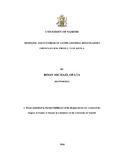Modeling and synthesis of antiplasmodial benzoxazines from natural products of Kenya
Abstract
Natural products research has taken place in Kenya for decades. This has led to the explosion
of data about natural products which largely remains scattered in theses, published articles
and books of abstracts and proceedings. As a result, natural products of Kenya are not
accessible for drug design studies. Therefore the objective of this study was to create a webbased
database of natural products of Kenya and use it in molecular modeling studies for
the design of antiplasmodial compounds.
Currently the database contains 1112 compounds. It has been named Mitishamba, a
Kiswahili word referring to herbal medicine and is hosted online at
(http://mitishamba.uonbi.ac.ke). The compounds in the database were utilized in the
generation of suitable fragments for molecular modeling studies using the OpenyEye
scientific software suite. Benzoxazine scaffold was identified as a suitable molecular
framework, due to its similarity to Primaquine (an existing antimalarial drug). Analogs of
the scaffold were generated and subjected to docking against the target, 3D shape
comparison and electrostatics studies with promising molecules synthesized and assayed.
A validated Plasmodium falciparum enzyme target, Plasmodium falciparum dihydroorotate
dehydrogenase (PfDHODH), was used in the docking studies. Three benzoxazines, 7-
Methoxy-4H-1, 4-benzoxazin-3-one (25), (7-methoxy-3-oxo-1,4-benzoxazine-4-
carbaldehyde (54) and 4-acetyl-7-methoxy-1,4-benzoxazin-3-one (56) were synthesized
and then subjected to in vitro antiplasmodial assay against chloroquine resistant K1 and
chloroquine sensitive 3D7 strains of P. falciparum. The results showed 7-methoxy-3-oxo-
1,4-benzoxazine-4-carbaldehyde had an activity of 11.05 μg/mL against chloroquine
resistant K1 isolate while 4-acetyl-7-methoxy-1,4-benzoxazin-3-one had an activity of
8.32ug/mL. The latter has activity classified by the WHO as active and should be pursued
further through optimization to investigate its antimalarial potency.
The results above demonstrate the potential use of the database in the identification of lead
antiplasmodial compounds. Therefore more benzoxazine derivatives should be identified
through virtual screening and synthesized to optimize their antiplasmodial activity.
Publisher
University of Nairobi

